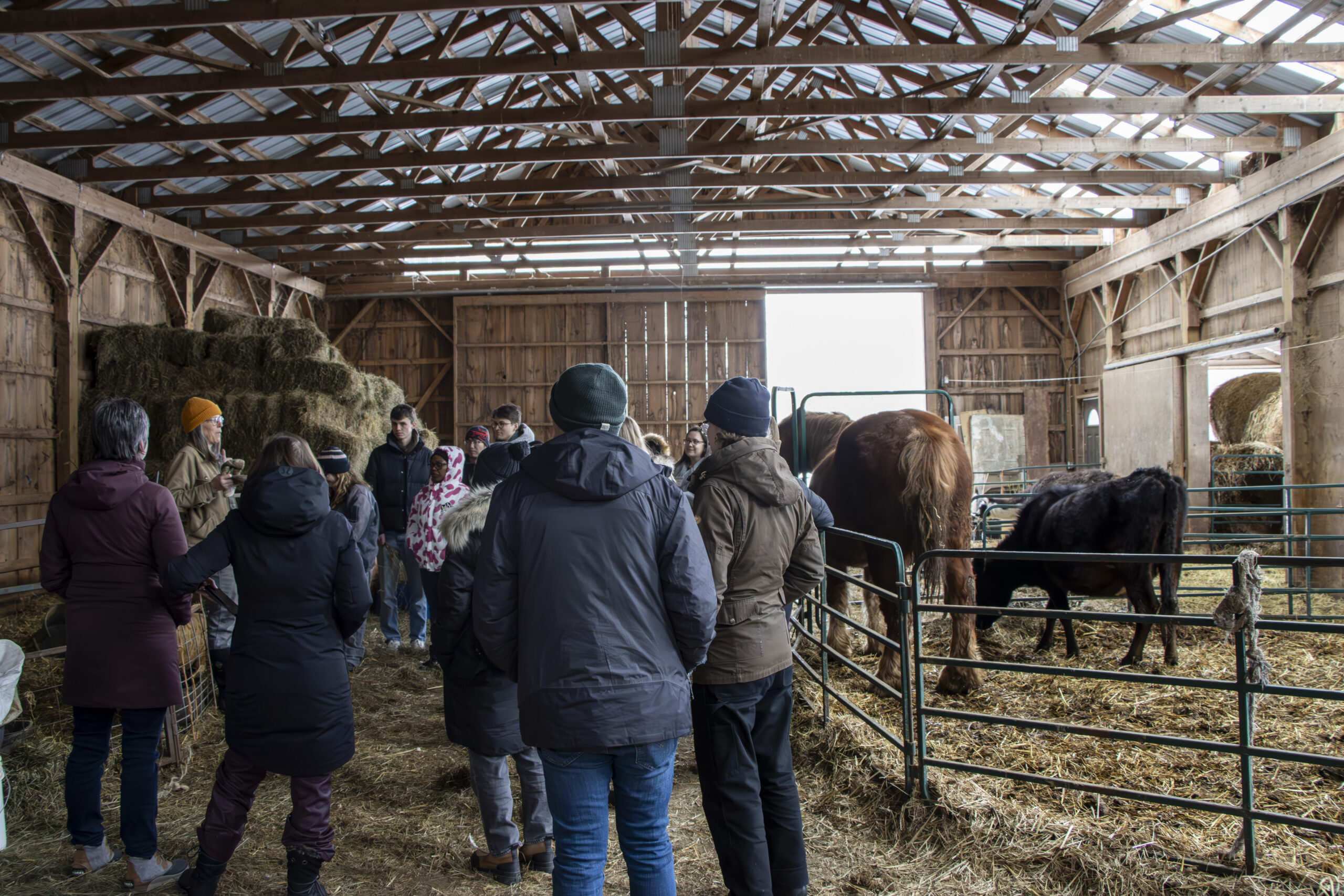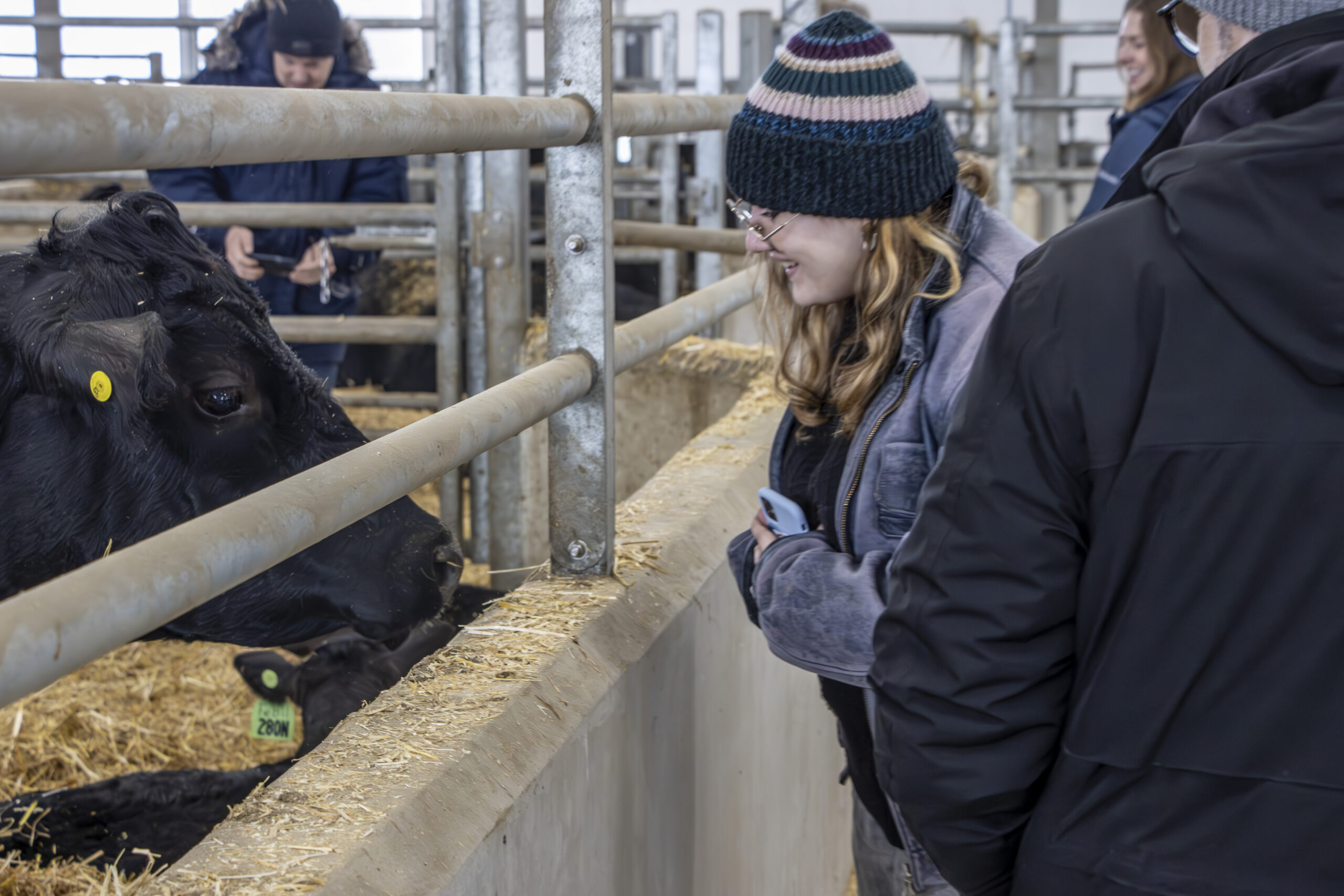Julia Brahy, Master of Global Affairs Candidate & CARE Scholarship Recipient, Munk School of Global Affairs & Public Policy.

The final day of the CARE Conference 2025 featured an immersive field trip to key agricultural and environmental research sites in Ontario, offering participants a unique opportunity to engage with practitioners and researchers developing innovative strategies in regenerative agriculture, sustainable livestock management, and soil health research. The itinerary included visits to Heartwood Farm & Cidery in Erin, the Ontario Dairy and Beef Research Centres in Elora, and a panel presentation by the Soils at Guelph initiative at the University of Guelph. These visits highlighted interdisciplinary efforts in addressing greenhouse gas emissions, enhancing biodiversity, and advancing data-driven soil conservation.
Heartwood Farm & Cidery
Heartwood Farm & Cidery, co-owned by Val Steinmann and Brent Klassen, exemplifies a model of regenerative agriculture that emphasizes localized supply chains, biodiversity, and cyclical farming systems. Participants explored the farm’s holistic approach to integrating multi-species grazing with fruit and nut orchards, bee hives, and maple syrup production. The discussion focused on the interrelationship between species, particularly the role of pasture-grazing pigs in maintaining orchard hygiene. The pigs contribute to pest control and soil enrichment, demonstrating how ecological communities of plants and animals can work together to sustain productivity.

In addition, the farm’s collaboration with the Ecological Farmers’ Association of Ontario (EFAO) promotes cross-farm knowledge exchange, reinforcing how regenerative farming techniques can be scaled across diverse agricultural landscapes. Additionally, Heartwood Farm is involved in field experiments exploring carbon sequestration strategies and the role of beneficial fungi in soil health, addressing concerns about the depletion of carbon in agricultural soils. The visit underscored the global significance of small farms, which supply food to approximately 80% of the world’s population, and the need to integrate Indigenous knowledge systems to create more resilient agricultural practices.
Ontario Dairy and Beef Research Centres
The next stop was the Ontario Dairy and Beef Research Centres in Elora, operated through a partnership among Agricultural Research and Innovation Ontario (ARIO), the Ontario Ministry of Agriculture, Food and Rural Affairs (OMAFRA), the University of Guelph, and the Ontario beef and dairy industries. Dr. Christine Baes, a leading researcher in livestock genetics, guided the tour of the Dairy Research Centre, presenting groundbreaking work in genetic evaluation for low-methane dairy cows. The center’s breeding programs assess over 100 physical traits to select cows that produce less methane without compromising milk production.
Participants also explored the research facility’s free-stall barns and robotic milking systems, which feature automatic greenhouse gas detection through compression filtration. A key takeaway from the visit was the emphasis on sustainability as a balance of economic, societal, and environmental factors. The dairy industry has invested $40 million into the world’s first bovine methane detection system, enabling real-time tracking of emissions and allowing for precise adjustments in feed and breeding strategies. Additionally, protocols ensure newborn calves receive colostrum within an hour of birth to improve survival rates, and semen selection is strategically used to favor female births, optimizing herd sustainability.

At the Beef Research Centre, Dr. Katie Wood led an in-depth discussion on methane emissions in beef cattle, highlighting the link between feeding behavior, gut microbiome composition, and methane output. The research team employs C-Lock GreenFeed systems to measure methane and carbon dioxide emissions directly from cattle, sampling gases at a rate of four times per second. Participants also learned about the flexibility of pasture organization, with rotational grazing practices being utilized to enhance feed efficiency and soil carbon storage. Black Angus cross cows are at the center of ongoing studies investigating the relationship between meat quality, consumer preference, and methane mitigation. The facility collaborates with international industry partners to refine best practices, ensuring research findings are applied to real-world production systems. The integration of biogenic gas research, stock gas monitoring, and advancements in genetic selection all contribute to reducing the carbon footprint of beef production.
Soils at Guelph Panel and Presentation
The field trip concluded with a panel presentation by the Soils at Guelph initiative at the University of Guelph. The panel, featuring Dr. Claudia Wagner-Riddle, Dr. Kari Dunfield, Dr. Asim Biswas, and Knowledge Mobilization Manager Heather White, focused on the role of soil science in mitigating climate change. Dr. Wagner-Riddle’s research has led to the development of tools aimed at reducing greenhouse gas emissions in agriculture, influencing adoption at a national scale. Moreover, Dr. Dunfield discussed her work on microbial communities and crop rotations, illustrating the relationship between soil biodiversity and greenhouse gas emissions. Additionally, Dr. Biswas emphasized the importance of sensor-based soil information in developing sustainable soil management strategies. Heather White addressed the importance of knowledge mobilization, ensuring that research findings are effectively communicated to farmers, policymakers, and industry stakeholders.
The discussion emphasized that soil functions as a vital component of climate adaptation, acting as both a carbon sink and a contributor to agricultural emissions. Canadian agriculture accounts for 44% of the country’s methane emissions, 40% of its nitrous oxide emissions, and 21% of its carbon dioxide emissions. Addressing these challenges requires an integrated approach: measurement, modeling, mapping, management, and monitoring. The research team is involved in international collaborations, including the Global Nitrogen Innovation Centre for Clean Energy and the Environment and the UNEP International Methane Emissions Observatory, positioning Canadian soil research within a broader global context.
Notably, a major theme of the session was the “quiet extinction” of invertebrates and the growing urgency to incorporate soil biodiversity into climate and agricultural policy frameworks. The panelists also highlighted significant data challenges in soil science, including spatial variability, temporal monitoring, and data gaps in critical regions. Traditional soil sampling methods are increasingly seen as insufficient to meet the needs of modern agriculture, climate modeling, and policy development.
Conclusion
This field trip provided a comprehensive and multidimensional exploration of the intersection between sustainable agriculture, technological advancements, and climate mitigation. The collaboration between government agencies, industry partners, and academic researchers underscores the necessity of an integrated approach to addressing environmental challenges in food production. By fostering stronger links between research, policy, and practical implementation, these initiatives offer a pathway toward a more regenerative and emissions-conscious agricultural system. The knowledge and methodologies shared across the three site visits demonstrate how local innovation can scale into broader, globally relevant solutions to ensure food system resilience in the face of climate change.